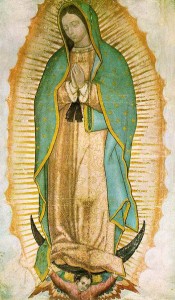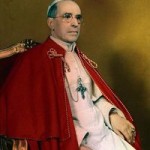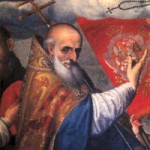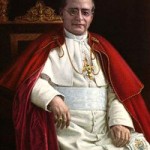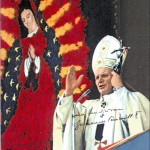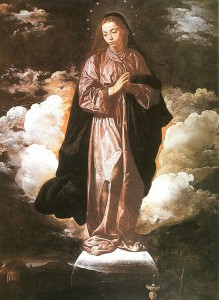On one of the exterior walls of La Placita church in downtown Los Angeles, may be seen a huge image of Our Lady of Guadalupe, surrounded by images of all the Western Hemisphere countries, and surmounted in English and Spanish by the title, “Empress of the Americas.” This refers to the granting of said title to that image by Pius XII on October 12, 1945, in commemoration of the crowning of the miraculous picture at the command of Leo XIII, 50 years earlier. Now, the universal Queenship of Mary in the light of her Divine Son’s Kingship is a matter of Catholic Faith; but her special relationship to the evangelization of the New World, and most especially through her apparition at Guadalupe in Mexico, is what has led to the granting of this title. It is no mere gesture, nor a nod to history: rather, the Sovereignty of the Virgin over the Western Hemisphere is an ongoing reality which may not be ignored.
Most of us are doubtless aware of the apparition of the Virgin to the Indian, St. Juan Diego, at the Hill of Tepeyac near Mexico City in 1531. When St. Juan asked the Woman before him, dressed as an Aztec princess, who she was, her Nahuatl response included the phrase te coatlaxopeuh (pronounced “te quatlasupe”), meaning “One who crushes the head of the stone serpent.” To the Spaniards, this had two meanings. Quatsalupe sounded to them like “Guadalupe,” a great Marian shrine in Spain; but the exact translation recalled the prophecy in Genesis of the Woman crushing the serpent’s head.
With its bi-cultural message, the occurrence at Guadalupe and the miraculous image that resulted galvanized evangelization in Mexico. Millions of Indians converted in a very few decades as a result. Devotion to the Mexican image went back to Europe. Four decades after the Virgin appeared to St. Juan Diego, one of her most devout clients was the Genoese Admiral, Andrea Doria. He was one of the three admirals despatched to repulse the Turkish fleet which was menacing the Mediterranean at the time. The Pope, St. Pius V, had mobilized the Catholics of Europe to say the Rosary for the victory of the Christian ships; defeat would result in untold horror for the coasts nearest the Ottoman-held lands, including Italy itself (bear in mind that so late as the 18th century, whole Irish and Icelandic villages were raided and carried off into slavery by the Barbary pirates; a small taste of what was in store in the event of a Turkish victory).
Doria carried a small copy of the Tilma of Guadalupe into battle, when the two fleets met at Lepanto on October 7, 1571. The resulting fight was an overwhelming victory for the heavily outnumbered Christians. St. Pius V was supernaturally aware of the triumph when it occurred, before messengers could arrive, and ordered the Te Deum sung. He declared the day of the battle to be the Feast of Our Lady of Victories, altered a few years later to Our Lady of the Rosary — this observance would be extended to the whole Church in 1716, in gratitude to Our Lady for the victory over the Turks at Peterwardein that year. Don Andrea donated the image of the Virgin of Guadalupe to the church of St. Stephen, in the town of Santo Stefano d’Aveto where his family owned a castle; it is enshrined there over the High Altar to this day. Cementing the connection between the two independent shrines, a Turkish warship lantern was donated to the Shrine of Our Lady of Guadalupe in Spain.
In Mexico, Christians living in areas still close to raiding pagan tribes invoked Our Lady of Guadalupe’s protection, but nowhere was she more venerated than in Mexico City itself. In 1737, she was made patroness of the capital, and a decade later of the whole Viceroyalty of New Spain — which in time would include all of Spanish America from Costa Rica north to Oregon, the Spanish West Indies, the Philippines, and the Marianas. Benedict XIV composed a proper liturgy for her feats, promulgating it in 1754. In the Wars of Independence in Mexico, both Royalists and Republicans appealed to her patronage, and during his short lived rule as Emperor of Mexico, Maximilian named his highest order of Knighthood after her (one of its medals is on display at the Treasure Chamber of the Hofburg in Vienna). Leo XIII not only had the image crowned, as we have seen, but extended her feast to all of Latin America. Several dioceses in the United States also took it up, including Monterey-Los Angeles. St. Pius X made Our Lady of Guadalupe patroness of all of Latin America in 1910, and Pius XI placed the Philippines under her patronage a quarter century later. All of his successors have honored her Empire over the Americas since.
But of course, one cannot see the Virgin of Guadalupe in isolation; during the Mexican wars of independence, although devotees of Guadalupe were to be found on both sides, the Royalists were particularly fond of Our Lady of Remedies. This image had been brought from Spain in 1519, and had served as protectress of the Conquest. After many adventures (she had been set up on the altar for the first Mass in Mexico City, hidden by the Spanish when they were forced to flee the Aztec capital, found twenty years later and venerated by local Indians, and solemnly processed whenever drought threatened Viceregal Mexico), Our Lady of Remedies was considered particularly Spanish. To some of the less educated on both sides, the Revolution was seen as a war between the two Madonnas!
Today, of course, the devotees of the two shrines are reconciled. But what is important to remember is that all forms of Marian devotion are inseparable, as the battle of Lepanto shows so clearly: the two shrines, Spanish and Mexican, of Guadalupe; Our Lady of Victories (to whom churches were dedicated in Rome, Paris, and Quebec); and Our Lady of the Rosary.
Every nation of the Americas has a national shrine or apparition site dedicate to Our Lady — and there are hundreds of local ones. These are not different “incarnations” or anything of that sort; instead, just as the Mother of God works with us as individuals to foster our own salvation, so too does she work with different peoples, nations, and provinces. As John Paul II prayed on December 8, 1993: “Allow us, Mary, to join your pilgrimage through the countries of Central America and South America, where you are so well known and revered. From Guadalupe, Mexico, to Aparecida, Brazil, from Lujan in Argentina to Caridad de Cobre, Cuba, from Coromoto in Venezuela, to Copacabana in Bolivia and many other places … Mary is a pilgrim with us along the paths of the world…”
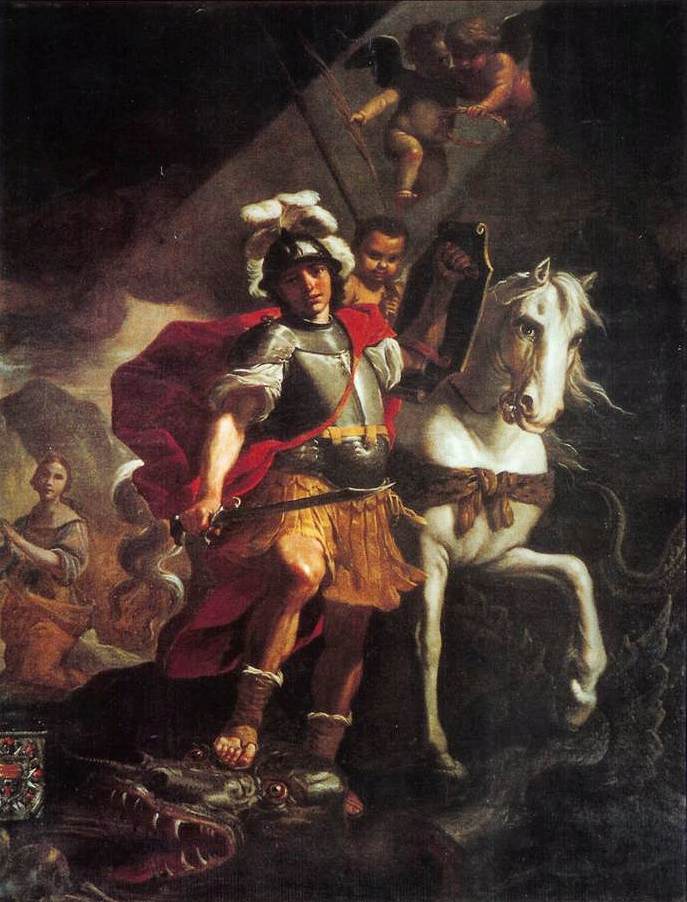
PRETI, Mattia, St. George Victorious over the Dragon, 1678
As at Lepanto, the Catholic nations of the Americas have always looked to the Virgin for defense as well as spiritual guidance and sustenance. During the Wars of Independence, as in Mexico, both sides placed their causes under the patronage of the Virgin. In token of this, various images of Our Lady are honored as Field Marshal, General, and/or Admiral by the Army and Navy of various Latin American countries and of Spain as well. It is important to remember, however, that this military status is not seen as a glorification of conflict itself by the Virgin, but rather an unending prayer for peace and reconciliation between foes. This custom, together with that of assigning saintly patrons for different branches of the military (St. Barbara for the Artillery, St. George for the Cavalry, and so on) may seem odd to many in North America. But such patronage reminds us that all aspects of national life — especially one so crucial as defense — requires Heavenly aid to bear good fruit.
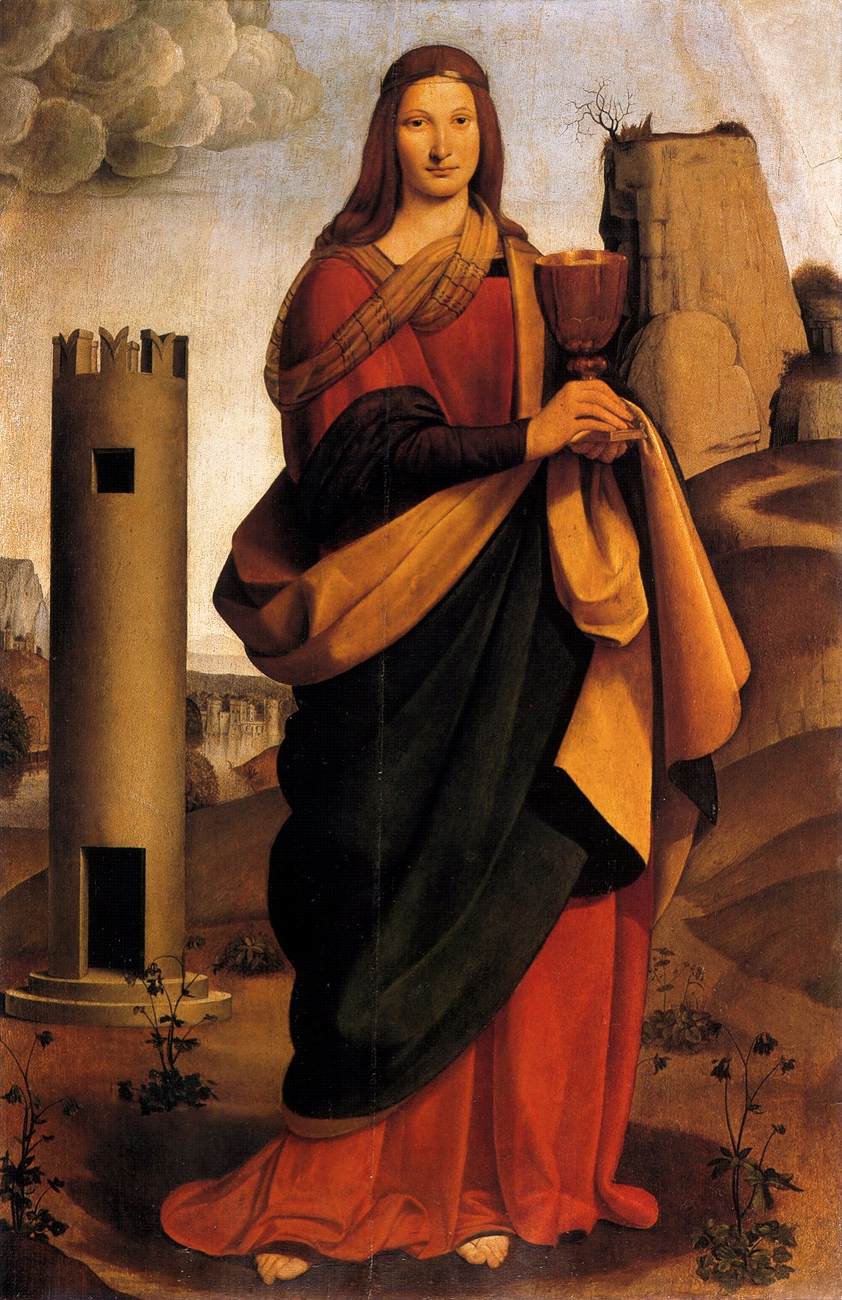
BOLTRAFFIO, Giovanni Antonio, St Barbara, 1493-99
Today, when throughout the Americas and the Philippines, both the Faith and the basic human values she upholds, (such as the sanctity of life and the family) are under attack by many inside and outside of government, it is essential to remember for ourselves and to remind our leaders that Mary’s Empire over the Americas is an important province of her Queenship and her Son’s Kingship over all the Earth. As successive Popes have instructed us, this is not a cry for power or privilege. Rather, it is the only means of salvation and happiness for us all, as individuals and as nation. The manner of recognizing this fact will vary from place to place. But the reality of it must never be forgotten.
